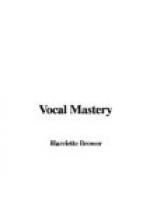At the close of the concert we had a brief chat with her. The next day she was present at the morning concert. This time she was gowned in black, with an ermine cape thrown over her shoulders. The Arch-duke sat beside her in the arm chair, as he had done the evening before. We had a bow and smile as she passed down the aisle.
We trust the Mozarteum in Salzburg, for which Mme. Lehmann has labored with such devotion, will one day fulfill its noble mission.
LEHMANN THE TEACHER
As a teacher of the art of singing Madame Lehmann has long been a recognized authority, and many artists now actively before the public, have come from under her capable hands. Her book, “How to Sing,”—rendered in English by Richard Aldrich—(Macmillan) has illumined the path, for many a serious student who seeks light on that strange, wonderful, hidden instrument—the voice. Madame Lehmann, by means of many explanations and numerous plates, endeavors to make clear to the young student how to begin and how to proceed in her vocal studies.
BREATHING
On the important subject of breathing she says: “No one can sing without preparing for it mentally and physically. It is not enough to sing well, one must know how one does it. I practice many breathing exercises without using tone. Breath becomes voice through effort of will and by use of vocal organs. When singing emit the smallest quantity of breath. Vocal chords are breath regulators; relieve them of all overwork.
“At the start a young voice should be taught to begin in the middle and work both ways—that is, up and down. A tone should never be forced. Begin piano, make a long crescendo and return to piano. Another exercise employs two connecting half tones, using one or two vowels. During practice stand before a mirror, that one may see what one is doing. Practice about one hour daily. Better that amount each day than ten hours one day and none the next. The test will be; do you feel rested and ready for work each morning? If not you have done too much the day before.”




